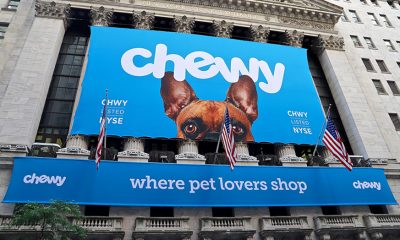Shopper Insights
Linking Consumer Behavior to Design Messaging
It can be the make or break point with your target audience.
Published
7 years agoon
By
Keith LoriaA PICTURE MAY PAINT a thousand words, but the design message on a package can result in even more, affecting consumer or shopper actions.
“Understanding consumer behavior and identifying the exact buying motivators, hot buttons, and the specific ‘conversion factor’ for that target audience is the differentiating factor between a good design and a great design — one that engages, motivates, and is truly effective,” says Gillian Christie, founder and CEO of adVenturesAcademy. “Design message on packaging can be the make or break point with your target audience.”

Every design message offers an emotional tone and subconscious connotations that influence a consumer’s perception of that package pretty much instantly.
For example, adVenturesAcademy was brought in to lead the evolution of a brand called Soy Delicious so the team went through its Conversion Market Research methodology to identify the key challenges the brand was having when they expanded from the natural channel into mainstream grocery.
“We uncovered the key consumer issues and evolved the brand to So Delicious,” Christie says. “This enabled them to expand beyond soy into coconut, rice, and beyond, while also engaging a much broader audience with the ‘dairy-free’ positioning their consumers wanted positioned with beautiful imagery that aligned with the various flavors—all key buttons from the market research.”
Selwyn Sherrill, creative strategy and design manager for WestRock, notes exploring the dynamics that shape consumers’ lives and influence their decisions will begin to paint a picture of why they behave the way they do.
“Brands can leverage this information to tailor their design messaging so that it links clearly to the values of the consumer as well as ties back to the values of the brand,” she says. “We’ve found that consumers respond well to brands that are able to convey a sense of authenticity, allowing consumers to more easily connect with what that brand stands for, which results in a more emotion-based purchase decision.”
Following Trends
Roy Oomen, labels and packaging category manager for Hewlett Packard, notes consumers are increasingly looking and requesting ways to control designs, or at least to provide input. Coca-Cola used HP technology to release millions of soda bottles with individual designs so that each customer could have a one-of-a-kind brand experience.
“This trend is a great opportunity to create more consumer intimacy and in some cases provides an unexpected moment of pleasure or satisfaction,” he says. “Some brands are in some ways even replacing the traditional greeting card. M&M’s for instance now offer sports team options. These custom products are significantly changing the designers’ impact factors.”
The sustainability trend is another huge influencer for consumers today. Sherrill says that if you imagine two comparable brands, both with highlighted eco-friendly claims, but whose products are in noticeably different packaging, it could make a huge difference in what sells.
One is packaged in a minimally branded, kraft substrate with a window area displaying the object inside. There is a story on the side that tells the origin of the company, along with the materials that went into creating the product. The other is packaged in a glossy substrate with a very eye-catching foil-stamped logo across the front. A perfectly rendered image of the product is shown to represent what’s inside.
“Which package feels more authentic and substantiating of the eco-friendly claims they’ve each made?” she asks. “I’d argue the kraft package with visibility to the product inside conveys a more honest and natural look and feel. This matters because research shows that consumers are willing to pay a premium for brands that they believe share their commitment to sustainable practices and products. So being able to communicate this message clearly and effectively on packaging is critical for a sustainable brand’s success in the marketplace.”
Jill Ahern, senior director, consulting solutions, packaging for Havi, says most companies recognize emotional connection rather than information as the primary goal of design as most purchases are based in emotion.
“Part of our role is to communicate information about the product to the consumer; however, given that the majority of consumers read only a fraction of the information on a package, these quality perceptions typically come first from design cues,” she says. “And, they are the foundation of a consumer’s decision about what to purchase.”
Ahern says that because consumers tend to carry and consume beverages outside of their homes, the brand packaging serves as an accessory of sorts for personal association through the person in possession, e.g., a form of consumer expression.
“The best examples are premium water, trendy ready-to-drink beverages like tea and kombucha, beer and even sports drinks,” she says. “You will easily see that consumers can make themselves feel and appear trendy, powerful, healthy or edgy just by the design of the beverage container they choose.”
AdvertisementThe Greatest Influence
Every design message, whether text or image-based, is power-packed with emotional tone and subconscious connotations that influence a consumer’s perception of that package rather instantly.
“Color, white space, size of elements and use of attractive imagery and well rendered images all matter greatly for providing an optimal impact for a specific design,” Oomen says. “Special effects such as refractive patterns, rainbow patterns and embellishment such as foil or spot varnish which accentuate specific design elements are in many cases real differentiators for creating.”
A brand is the culmination of the layout, color, messaging, imagery and how all of those elements come together to create a cohesive brand experience that aligns with target audiences’ specific emotional triggers and buying motivators.
“Brands need to be aware of how each design decision (color, shape, style, image, etc.) will come together on packages to tell a unique story,” Sherrill says. “And if the story is compelling enough to cause the consumer to pick the package off the shelf, we know that once it’s in their hands, they’re far more likely to purchase it.”
Examples include gluten-free messaging, no-GMO/GMO messaging, fair trade statements, bold photos of natural ingredients, Glow-in-the-Dark effects for play value, pearlescent effects to enhance moisturizing/cooling/soothing, etc.
“Design messaging ideally helps consumers readily zero in on key attributes such as brand, products/ingredients inside, product performance, convenience, and size/quantity,” adds Charles Hicks, WestRock’s director, design services. “For brand building and strengthening consumer loyalty, the design messaging we add to packaging needs to speak to consumers on a visceral level at the shelf, but more importantly it needs to reinforce their decision to pick it up and put the item in their basket.”
Oomen notes that in some cases the preference is not on graphics but more the design structure of the package—how small is it? How easy is it to seal and reopen, or can the product be preserved?
“A package sends a very clear message in many cases, not only on a level of graphic design but also with layout, format, size, shape, opacity and container style,” he says. “Examples often cited are which Emojis to put on a bottle, or which names to select if a collection of a personalized name is chosen as part of a design. Clearly all of these choices cited require meetings with stakeholders, cultural considerations and information about demographics.”
AdvertisementOnline trends
Kim Mudar, research and development program director for Sealed Air Corporation notes that the design message is also an extremely important area for e-commerce.
“Secondary package design for online purchases and the resulting customer experience at the point of delivery are vitally important to all entities in this growing value chain,” she says. “Consumer reactions to e-commerce packages can be quantified, and these opportunities for delight are worthy investments to provide a positive consumer experience and to maintain brand loyalty.”
According to recent research conducted by the University of North Carolina at Charlotte, and sponsored by the company, e-commerce secondary package design with carefully selected branding, opening features and/or delightful presentation can greatly affect brain activity, unconscious emotions, facial expressions and brand recognition, all of which influence the chances of repeat purchases.
“Carefully selected brand messaging on e-commerce packages evoked twice as much unconscious, surprised facial expressions than plain package designs,” Mudar says. “Millennials were 25 to 50% less impressed by highly specialized package designs than older generations.”
The Final Word
The link between behavior and design is of the utmost importance, and it is bidirectional—design influences behavior and in turn, behavior influences design.
“Great design begins with empathy, and a deep understanding of what users do, want and need from their relationship with the product,” Hicks says. “In general, package design is successful if it creates a user response.”

SPONSORED VIDEO
Branding with Ferocity – Thinking Like an Indie Brand
Get a better understanding on how to leverage new technologies to engage and delight shoppers, sustainability’s role in product and package design – being sustainable and premium are not mutually exclusive, plus best practices and tips for collaboration and how to launch new products and refresh existing product line-ups and brands.
You may like
Advertisement

GO MINIMALISM . . . HOLD ON A MINUTE!
Sustainable, 100% Recycled Transparent Sheeting is Now a Reality!

Kroger, Walgreens to Dedicate Section of Their Stores to Reusable Packaging

6 Marketing Tips for Ecommerce Brands to Win the Holiday Shopping Season

New Wunderoots Branding Celebrates the Carrot

Fact or Fiction? The Truth about Eco-Friendly Packaging

BXP May 2021 Think & Clink

Unilever Raises Bar for Accessibility with Degree Inclusive

Crown Royal’s Limited-Edition Pack Designed by Oscar-Winner

Coca-Cola Explores World of Paper Bottles
Subscribe

BULLETINS
Get the most important news and business
ideas from BXP Magazine's news bulletin.
Latest Tweets
Advertisement








